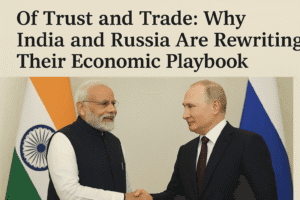Of Trust and Trade: Why India and Russia Are Rewriting Their Economic Playbook
In a significant shift beyond traditional diplomacy, India and Russia are strategically recalibrating their economic partnership to address modern global vulnerabilities. This new approach, moving past mere trade volume targets, focuses on building resilient supply chains and ensuring mutual dependability in an uncertain world. The partnership acknowledges the urgent need to diversify a currently lopsided trade relationship and correct a significant deficit.
The synergy is clear: India offers a massive, high-growth market hungry for Russia’s resources and industrial goods, while Russian consumers and industries stand to gain from India’s competitive manufacturing and skilled talent pool. Concrete progress is already underway, including a breakthrough on a free trade agreement with the Eurasian Union and work on smoother financial payment systems. The core message is a call to action for businesses on both sides to step forward and translate this high-level strategic alignment into tangible projects and joint ventures, ensuring the relationship’s long-term sustainability.

Of Trust and Trade: Why India and Russia Are Rewriting Their Economic Playbook
In a world of economic uncertainty, some partnerships are going back to basics. At the India-Russia Business Forum today, External Affairs Minister Dr. S. Jaishankar outlined a quiet but profound shift in one of the world’s most steady, yet underdeveloped, economic relationships.
Gone are the simple promises of boosting trade volumes. The dialogue has matured into a harder-nosed, more strategic conversation about building a partnership resilient enough for a turbulent era.
The Five Global Shocks Reshaping a Bilateral Relationship
Minister Jaishankar framed the India-Russia partnership not in a vacuum, but as a direct response to the defining disruptions of our time. His speech identified five key lessons the world has learned:
- The Premium on Dependability: In crises, steady partners are worth their weight in gold.
- The Fragility of Long Chains: Shorter, more secure supply chains are no longer a luxury but a necessity.
- The Risk of Concentrated Markets: Over-reliance on a few buyers is a strategic vulnerability.
- The Peril of Single Suppliers: Being over-exposed to one source for critical goods is a massive risk.
- The Cost of Complacency: Failing to continuously research new opportunities and partnerships leads to irrelevance.
This list is more than a diagnosis of global ills; it’s the strategic blueprint for the new India-Russia economic agenda.
Beyond the Headline Number: The Urgent Need to Balance the Books
While recent years have seen a dramatic spike in bilateral trade, the Minister pointed to an open secret: the growth is lopsided. A significant trade deficit threatens the long-term sustainability of the relationship. The real challenge, therefore, isn’t just growing trade, but diversifying it and creating a more balanced exchange of goods and services.
This is where the compelling logic of complementarity takes center stage.
India’s Offer: A $4 Trillion Opportunity on the Move
Jaishankar laid out a clear-eyed invitation to Russian business, detailing the unmatched opportunities in India’s booming economy:
- Resource Hunger: An economy growing at 7% has an insatiable need for reliable resources.
- Assured Supplies: A guaranteed market for essential products like fertilizers, chemicals, and machinery.
- Infrastructure Access: A massive, rolling infrastructure boom needs expertise from proven enterprises.
- ‘Make in India’ Incentives: Production-linked incentives (PLIs) and other schemes have opened windows for foreign manufacturers.
- The Demand Wave: Modernization and urbanization are creating entirely new consumption patterns and lifestyle demands.
Russia’s Opportunity: Beyond Traditional Exports
The mirror image, as the Minister described it, is India’s emergence as a large-scale, quality producer. Russian consumers and industries could benefit from:
- Affordable, Accessible Goods: Indian pharmaceuticals and healthcare products are a global success story.
- Competitive Manufacturing: From auto components and electronics to engineering goods and fashion.
- Agricultural Synergies: Combining strengths in food and agriculture for mutual benefit.
- Skilled Mobility: Tapping into India’s vast talent pool to optimize for a global workplace.
From Vision to Reality: The Concrete Steps Already Underway
This isn’t just aspirational talk. The Minister highlighted tangible progress:
- The FTA Breakthrough: The completion of the Terms of Reference for an India-Eurasian Economic Union Free Trade Agreement is a game-changer, set to create a framework for seamless trade across a vast region.
- Solving the Money Problem: Both nations have recognized the impediment of financial channels and are actively working to create smoother payment and settlement mechanisms, moving beyond previous constraints.
- Connecting the Dots: Improving physical and digital connectivity through multiple corridors is being prioritized to move goods faster and cheaper.
The Bottom Line: It’s Now Over to Business
The most important message was one of synergy. Governments can create the conditions, but businesses must seize the moment. The Minister urged a closer alignment between what governments discuss in closed-door meetings (like the IRIGC) and what businesses plan in boardrooms.
The ultimate goal is clear: to build a strong and sustainable economic foundation that supports the enduring strategic partnership, creating a success story substantial enough to be celebrated at the Annual Summit between Prime Minister Modi and President Putin at the year’s end.
The message from New Delhi is that the India-Russia relationship is finally getting down to business—in a very literal sense.
You must be logged in to post a comment.